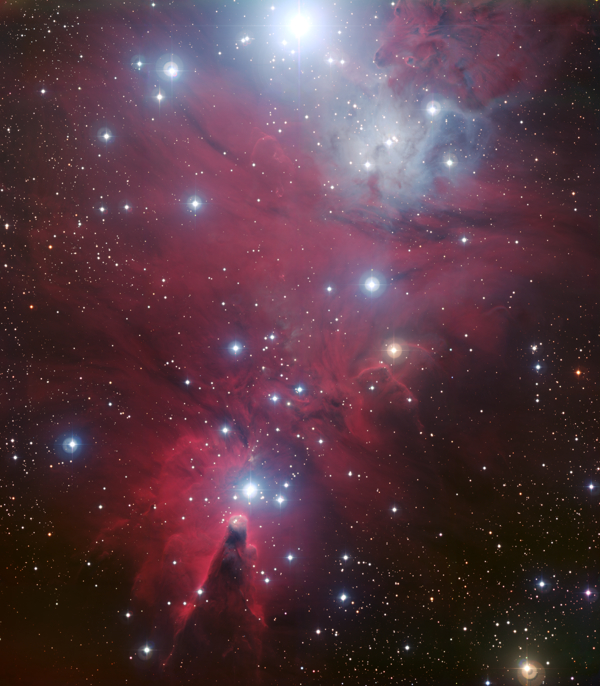NGC 2264 in Monoceros
January 2022 - Nebula and Cluster of the Month
Firstly, I would like to wish you a happy new year. We’ve had a couple of tough ones, so let’s hope for some highly visible improvements this year.
To start the new year, I’m going to be looking in some detail at a single object that incorporates both nebula and cluster. Located in Monoceros, nine degrees north of the celestial equator, it is easily accessible to observers in both the northern and southern hemispheres.
The nebula and the cluster, both now referred to as NGC 2264, were first observed by William Herschel. He found the cluster first, on 18 January 1784, describing it as Double and attended by more than 30 considerably large stars.
Evidently, Herschel did not see the nebulosity in which this cluster is wreathed until he revisited the object nearly two years later, on 26 December 1785. On that night, he noted Some bright stars 7 or 8' south preceding 15 Mon are involved in extremely faint nebulosity which loses itself imperceptibly.
It reads as though he was unaware that he had previously observed the cluster. He gave the cluster the designation 8 H.VIII, including it in his eighth class – ‘Coarsely scattered clusters of stars’, whilst giving the nebula the designation 27 H.V, placed in his fifth class – ‘Very large nebulae’.

The first word in the description of the open cluster – ‘Double’ – refers to the star he used as the basis for the position he gives for the cluster, 15 Monocerotis. 15 Mon is a double, but more than that, it’s the principal star in a complex multiple star system, the relationships between which are the subject of no fewer than 28 entries for 17 different stars in the Washington Double Star Catalogue. Seven of these stars are double or multiple stars in their own right.
15 Mon also bears the variable star designation S Mon. The variations are slight, from magnitude 4.62 – 4.68. S Mon is a young star with a spectral type of O7e. It has an absolute magnitude quoted from -2.6 to -5.1, which is confusing and unhelpful. Its mass is around 30 solar masses. The distance is problematic, with ground-based dynamical parallax and isochrone measurements consistently giving a distance of between 700 and 900 parsecs (2300–3000 light-years), whereas Hipparcos parallax measurements suggest a distance only half this.
The age of the cluster is between three and five million years.
Stripped of its nebulosity, the cluster itself is fairly unremarkable visually, though its resemblance to a Christmas tree has been noted, with S Mon forming the short trunk of the tree, and 7.2 magnitude HD 47887 (26’ almost due south of S Mon) representing the top of the tree. The Trumpler type of NGC 2264 is variously given as III3m n and III3p n. This indicates a cluster that is detached from its background but does not have a noticeable concentration towards the centre, that the stars have a wide range of magnitudes and that it is either medium rich or poor. The number of stars listed as members by various authorities range from 40 (Archinal & Hynes) to 222 (Luginbuhl & Skiff). One can only shake the head.
The overall magnitude of the cluster is consistently quoted as around magnitude 4.0, making it a naked-eye object under good dark skies, and otherwise an easy binocular object. Through my 12” (300mm) reflector, I found a large, bright cluster dominated at the north by 4.6 magnitude S Mon, which appeared to be surrounded by a nebulous haze. Two arms of stars stretch to the south where they meet at another fairly bright star, though there is a paucity of stars in the triangular area that they delineate.
The two stars at the extremes of the cluster, S Mon and HD 47887, are also the best spots to look at more carefully to see the nebulosity associated with the cluster. The whole of this nebulosity is given the designation LBN 912, but in addition, the brighter part by S Mon is also designated LBN 911. Under good conditions, both the nebulosity around S Mon and some hint of the nebula by HD 47887 (which is often called the Cone Nebula) can be detected visually. My observation of the area around HD 47887 (labelled LBN 912 on my observation) shows the brighter ‘cap’ to the Cone (which is itself a dark nebula). At the time of this observation, I noted that a tiny nebulous spot is visible where the tip of the Cone Nebula lies. Fainter nebulosity was barely visible around it.

Around S Mon lies the brighter nebulosity called LBN 911. This is the brightest and most easily seen part of the nebula. It is quite bright around S, making it look like the star is shining through very thin, high cloud. The other two patches seen, to the south-west, were much fainter.

If you are fortunate enough to have good dark skies, a tougher challenge is to see the Cone itself. The use of an OIII or UHC filter will considerably enhance your view of the nebulosity round here, sometimes the whole field has a gentle glow, and darker lanes can be glimpsed passing roughly east-west. If you have truly good skies, the Cone can be seen as a dark intrusion, often just a ‘nick’, in the very faint nebulosity south of HD 47887.
| Object | RA | Dec | Type | Magnitude |
|---|---|---|---|---|
| LBN 911 | 06h 40m 48s | +09° 51’ 00” | Bright nebula | - |
| NGC 2264 | 06h 41m 04s | +09° 43’ 06” | Open cluster + emission nebula | Cluster 4.0 |